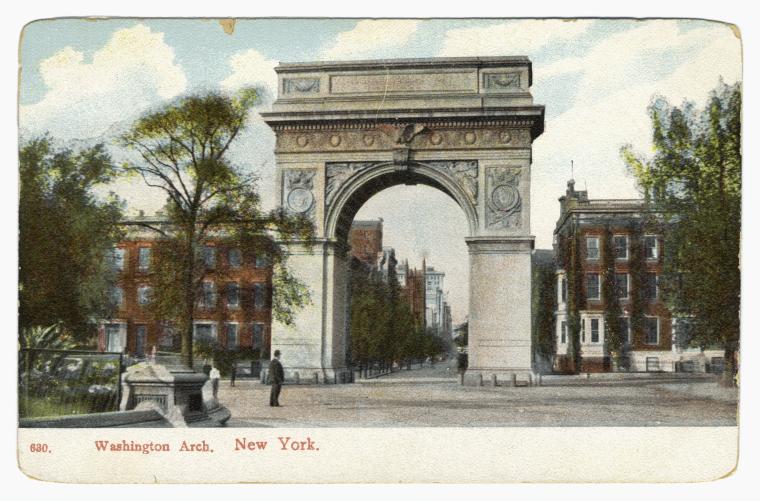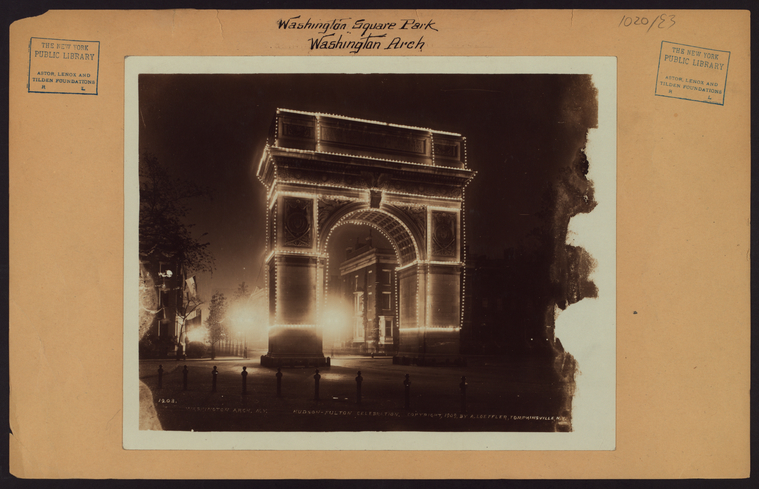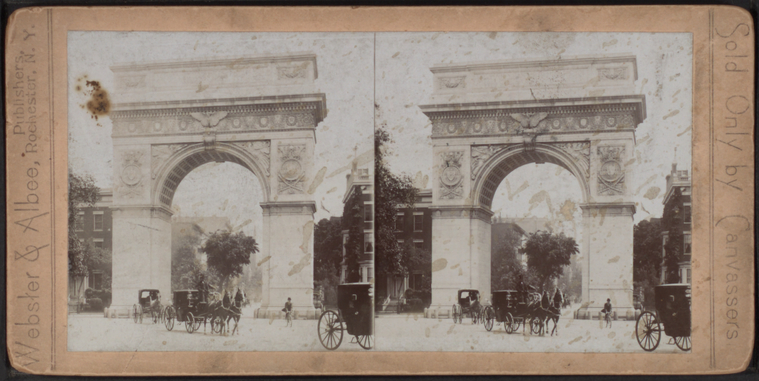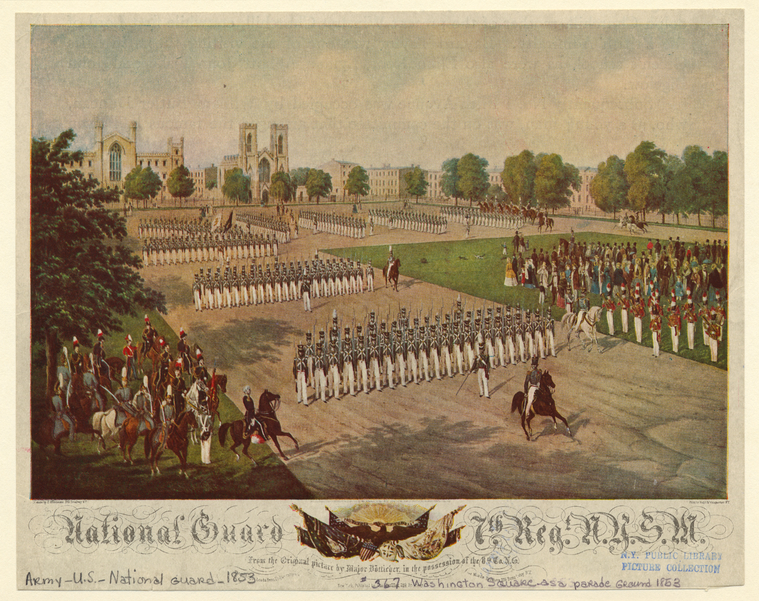NYC Neighborhoods
Beware of Zombies: The Grim Origins of Washington Square Park
Centered on Washington Square Park, Greenwich Village is a neighborhood made legendary by the world famous artists, musicians, and writers that have flourished and created within steps of its arch. However, what lies beneath that splendid, recently re-landscaped and renovated outdoor sanctuary is a bit more morbid.
In his 2003 book Around Washington Square, Luther S. Harris posed the question, “What had made Greenwich Village such an important seedbed for the growth and flowering of culture in New York City, the United States, and indeed the world?” Could it perhaps have been the fertilizing effects of the 20,000 or so human corpses that still lie beneath the park?

So, how did those bodies get there? In 1797, the quickly expanding New York City government purchased a portion of an old farm for $4,500 to create a potter’s field—a burial ground for the indigent, poor, criminals, and victims of epidemic. The potter’s field operated for almost thirty years and occupied what is now the eastern two-thirds of Washington Square Park. It also happened to be adjacent to several established church cemeteries, adding to the area’s body count. In Around Washington Square, Harris commented that this area was a “natural choice for such bleak facilities because it was a rural northern suburb of the city and already the site of cemeteries owned by downtown churches.”

Soon after the ground reached its capacity for human burials, mayor Philip Hone initiated his strategy for transforming the potter’s field into a public square. His intent was to raise the property values adjacent to the square, and it was related to a scheme to raise funding for a charity called Sailor’s Snug Harbor—but that is a story for another time. Hone’s models were prestigious London squares such as Belgrave Square. But instead of a private space like London’s squares, the mayor wanted to create a free public space. In 1827, courts agreed with him and Washington Square was legally declared a “public space.”
Initially called the Washington Military Parade Ground and used to celebrate the 50-year anniversary of the signing of the Declaration of Independence, the square’s moniker was soon shortened by the press to “Washington Square.” Naming public facilities after George Washington was extremely popular at the time, especially in conjunction with an Independence Day celebration. Landscaping, street work, and construction of fine houses soon followed. Some skeletons were even unearthed during this process, although there were no wide-scale efforts to completely disinter the crowded burial site.
The square did achieve Mayor Hone’s goal of raising the property values around it. Properties purchased by New York University (NYU), then known as the University of the City of New York, provide a striking example. In 1832, before the square was even completely finished, the school purchased the lots on the entire eastern block facing the square between Waverly and Washington Places. The price of the land had already risen steeply, and the university paid $40,000 for lots that had been evaluated at one-tenth that price only six years earlier, an act that completely wiped out their accounts. Harris says that after purchase NYU had only $66.46 in capital funds, while Nevius and Nevius say $6.40. Nonetheless, it was not enough money to run a university or fund the construction of the buildings. The school sank into debt, professors were not paid, and even the university’s book collection was mortgaged.
The real estate investment paid off very quickly. Within five years there was a 240% increase in property value and Washington Square was transformed from a Golgotha to a tranquil public space that continues to lend prestige and value to the surrounding neighborhood.
Regardless, in the event of zombie apocalypse, you now know one area to especially avoid.
For more information on some of the artistic, literary, and influential giants of New York culture that were nurtured in the “seedbed” of Greenwich Village, follow these links:
- Henry James
- Winslow Homer
- The Hudson River School Collective
- Edgar Allan Poe
- Herman Melville
- Walt Whitman
- Samuel Morse
- Daniel Huntington
- Samuel Colt
- Alexander Jackson Davis
- Eugene O’Neill
- Jane Jacobs
- Joan Baez
- Bob Dylan
- Pete Seeger
- Jackson Pollack
- Willem de Kooning
- Edward Hopper
- Allen Ginsberg
- Jack Kerouac
- William S. Burroughs
Read E-Books with SimplyE
 With your library card, it's easier than ever to choose from more than 300,000 e-books on SimplyE, The New York Public Library's free e-reader app. Gain access to digital resources for all ages, including e-books, audiobooks, databases, and more.
With your library card, it's easier than ever to choose from more than 300,000 e-books on SimplyE, The New York Public Library's free e-reader app. Gain access to digital resources for all ages, including e-books, audiobooks, databases, and more.
If you don’t have an NYPL library card, New York State residents can apply for a digital card online or through SimplyE (available on the App Store or Google Play).
Need more help? Read our guide to using SimplyE.


![Washington Square ; Semi - annual Art Exhibit.], Digital ID 730552F, New York Public Library Washington Square ; Semi - annual Art Exhibit.], Digital ID 730552F, New York Public Library](https://images.nypl.org/?id=730552F&t=w)
Comments
Wow! I live near by and never
Submitted by Anonymous (not verified) on March 12, 2011 - 6:26pm
Thank you for great job!
Submitted by Pavel Push (not verified) on March 15, 2011 - 4:31am
very interesting
Submitted by NYPL Staff on March 17, 2011 - 3:23pm
Another reason to love NYPL
Submitted by Karen S (not verified) on March 17, 2011 - 4:25pm
Washington Square Park
Submitted by James Brock (not verified) on March 17, 2011 - 5:54pm
Atmosphere
Submitted by Codex (not verified) on March 24, 2014 - 12:08pm
Don't forget Minetta Creek
Submitted by Bob Kosovsky (not verified) on March 25, 2014 - 2:18pm
Not only was this park used
Submitted by Pamela Norman (not verified) on May 2, 2014 - 12:28am
Reading this story re
Submitted by Josie Harrison (not verified) on May 2, 2014 - 3:10am
Iwas a runaway an lived in
Submitted by abbie bird (not verified) on March 27, 2015 - 9:41pm
Minetta Square
Submitted by Katherine Ellingotn (not verified) on November 7, 2015 - 2:01pm
Washington Square's history
Submitted by Cheese (not verified) on November 9, 2015 - 5:35pm
Wow! super creepy! I live in
Submitted by Guest (not verified) on July 12, 2018 - 9:24am
We need more fact-based, non
Submitted by HR (not verified) on October 21, 2018 - 6:30pm
Washington square
Submitted by Lesley Irvine (not verified) on November 2, 2018 - 4:35pm